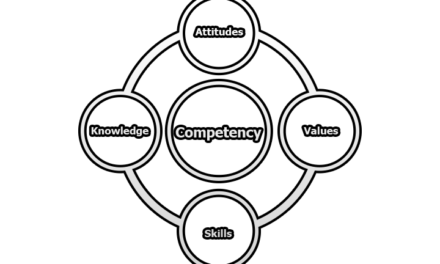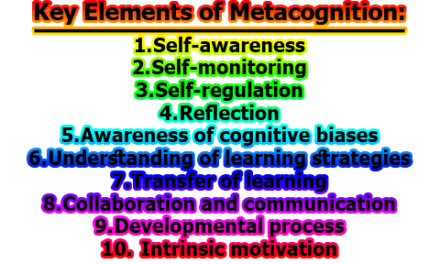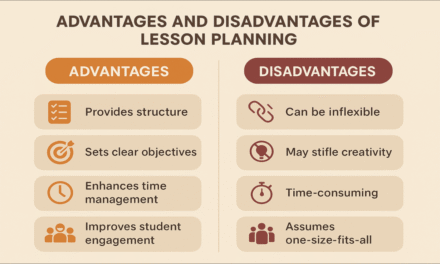The Effects of Teacher Accountability on Student Achievement:
Education is a cornerstone of modern society, and the quality of education is often seen as a key determinant of a nation’s future success. In this context, the role of teachers is paramount. Teachers are responsible for imparting knowledge, nurturing critical thinking, and shaping the minds of the next generation. It is therefore crucial to ensure that teachers are effective in their roles and that they are held accountable for their performance. Teacher accountability has been a subject of debate and research for many years. The idea behind it is simple: holding teachers accountable for their work should lead to improved student achievement. However, the practical implementation of teacher accountability policies and their impact on student outcomes is a complex and contentious issue. In this article, we will explore the effects of teacher accountability on student achievement.
1. Understanding Teacher Accountability:
1.1 What is Teacher Accountability?
Teacher accountability refers to the practice of holding teachers responsible for their performance and the outcomes of their students. It encompasses various aspects, including assessing teacher effectiveness, setting standards for teacher performance, and using the results of these assessments to inform decisions about hiring, firing, compensation, and professional development. The goal of teacher accountability is to ensure that every student receives a high-quality education.
1.2 Forms of Teacher Accountability: Teacher accountability can take several forms, each with its own set of mechanisms and implications:
- Standardized Testing: Standardized testing is one of the most prevalent and controversial forms of teacher accountability. It involves assessing student learning through standardized tests and attributing their performance to individual teachers. This form of accountability has been widely used in educational policy, particularly in the United States (Nichols & Berliner, 2007).
Proponents argue that standardized testing provides objective data on student achievement and helps identify underperforming teachers, thereby ensuring accountability (Ravitch, 2010). However, critics contend that it oversimplifies the complex process of teaching and learning, leading to unintended consequences such as teaching to the test and a narrowed curriculum (Koretz, 2002).
- Teacher Evaluation: Teacher evaluation systems are another common method of teacher accountability. These systems rely on a combination of classroom observations, self-assessments, and student feedback to gauge teacher effectiveness (Danielson, 2013). Teacher evaluations inform decisions about promotions, tenure, and professional development opportunities (Nunnery, Ross, & McDonald, 2015).
Teacher evaluation is seen as a more holistic approach to assessing teacher performance compared to standardized testing. It considers factors such as classroom management, lesson planning, and teacher-student interactions (Danielson, 2013). However, the effectiveness of teacher evaluation systems depends on their validity and reliability (Kane & Staiger, 2012).
- Value-Added Models (VAMs): Value-added models (VAMs) are statistical approaches designed to measure a teacher’s impact on student growth over time, accounting for various factors that may influence performance (Hanushek & Rivkin, 2010). VAMs are often used to assess teacher accountability by analyzing student test score data (Koedel & Betts, 2009).
VAMs aim to provide a more nuanced understanding of teacher effectiveness by considering student progress rather than just raw test scores (Harris & Sass, 2011). However, they are not without controversy, as they require complex statistical methodologies and may not accurately capture a teacher’s true impact (Hill, Kapitula, & Umland, 2011).
- Merit Pay: Merit pay is an accountability approach that links teacher compensation to performance. Teachers who meet certain benchmarks, such as improved student test scores or exemplary evaluations, receive bonuses or salary increases (Springer, Ballou, Hamilton, Le, & Lockwood, 2010).
Merit pay is designed to incentivize high performance and reward teachers who excel in their roles (Podgursky & Springer, 2007). However, it can be contentious, as it may lead to competition among teachers, create disparities in compensation, and raise questions about the validity of performance measures (Dee & Keys, 2004).
1.3 The Importance of Accountability: Accountability in education serves several vital purposes:
- Ensuring Teacher Effectiveness: Accountability measures help identify effective teachers and support their growth while addressing the needs of those who may require improvement (Darling-Hammond, 2017).
- Promoting Equity: Accountability can help address disparities in educational outcomes by highlighting where additional support is needed, especially in underserved communities (Harris & Sass, 2011).
- Data-Driven Decision-Making: Accountability systems provide valuable data that can inform educational policies and practices, leading to evidence-based improvements (Kane & Staiger, 2012).
- Resource Allocation: Accountability can guide the allocation of resources, ensuring that schools and teachers receive the support and funding they need to succeed (Ingersoll & Strong, 2011).
2. The Effects of Teacher Accountability on Student Achievement:
2.1 Positive Effects of Teacher Accountability:
- Increased Teacher Motivation: Teacher accountability can serve as a powerful motivator. Knowing that their performance is being monitored and that there are consequences for student outcomes, teachers may be more inclined to invest additional effort in their teaching (Murnane & Cohen, 1986). This increased motivation can lead to improved instructional practices, better lesson planning, and a stronger commitment to their students’ success.
- Improved Student Outcomes: One of the primary goals of teacher accountability is to enhance student achievement. When teachers are held accountable for their students’ progress, they are more likely to adapt their teaching methods to meet the specific needs of their classes (Hanushek & Rivkin, 2010). They may provide additional support to struggling students and implement evidence-based instructional strategies (Bruns, Luque, & Filmer, 2018). Consequently, student outcomes can improve, as evidenced by higher test scores and better academic performance.
- Targeted Professional Development: Teacher accountability systems often identify areas where teachers can improve. These areas are based on data from evaluations, test scores, or other performance metrics. As a result, teachers have the opportunity to participate in targeted professional development programs designed to address their specific needs (Ingersoll & Strong, 2011). This personalized approach can lead to professional growth and ultimately benefit students by enhancing teacher effectiveness.
2.2 Negative Effects of Teacher Accountability:
- Narrowing of Curriculum: One of the most significant criticisms of teacher accountability, particularly when tied to standardized testing, is the potential for a narrowed curriculum (Nichols & Berliner, 2007). To improve test scores and meet accountability targets, some teachers may focus disproportionately on tested subjects, neglecting other vital aspects of education such as critical thinking, problem-solving, and the arts (Ravitch, 2010). This narrowing of the curriculum can limit students’ exposure to a well-rounded education.
- Teaching to the Test: High-stakes standardized testing can lead to the practice of “teaching to the test.” In an effort to boost test scores and secure their own job security or bonuses, some teachers may emphasize test-related content and strategies at the expense of a broader education (Koretz, 2002). This approach can hinder students’ ability to think critically and apply their knowledge beyond the confines of standardized assessments.
- Stress and Burnout: The pressure associated with teacher accountability can lead to increased stress and burnout among educators (Ingersoll & Strong, 2011). Constantly facing the threat of job loss or financial penalties can have a detrimental impact on teacher well-being and job satisfaction (Borman & Kimball, 2005). High levels of stress and burnout can, in turn, reduce overall teacher effectiveness and negatively affect the classroom environment.
- Unintended Consequences: Teacher accountability systems, when overly reliant on test scores or narrow metrics, may inadvertently encourage unethical behavior. Some educators may resort to cheating on standardized tests, manipulating data, or focusing on improving the test performance of select students, all of which undermine the integrity of the educational system (Jacob & Lefgren, 2008).
3. Balancing Accountability and Teacher Autonomy:
The debate surrounding teacher accountability underscores the importance of finding a delicate balance between accountability and teacher autonomy. While accountability is necessary to ensure teacher effectiveness and student achievement, it should not compromise the quality of education or stifle teachers’ creativity and innovation (Darling-Hammond, 2017). To strike this balance effectively, education policymakers and administrators should consider the following strategies:
3.1 Clear Standards: Accountability systems should establish clear and well-defined standards for teacher performance that encompass a broad spectrum of teaching responsibilities, from classroom management to fostering a positive learning environment (Danielson, 2013). This approach ensures that teachers are held accountable for their multifaceted roles.
3.2 Professional Development: Rather than relying solely on disciplinary measures, teacher accountability should emphasize professional development and support (Harris & Sass, 2011). Providing teachers with the tools and resources they need to improve their practice can lead to more significant and sustainable improvements in student achievement.
3.3 Multiple Measures: Using a combination of assessment measures, including classroom observations, student feedback, and standardized test scores, can provide a more comprehensive view of teacher effectiveness (Kane & Staiger, 2012). This multifaceted approach reduces the risk of narrow teaching practices and encourages a well-rounded education.
3.4 Collaborative School Culture: Foster a collaborative school culture that values teacher input and autonomy (Darling-Hammond, 2017). Encourage teachers to participate in decision-making processes, curriculum development, and school improvement initiatives. A sense of ownership and autonomy can empower educators to innovate and tailor their teaching methods to meet students’ unique needs.
3.5 Continuous Feedback: Implement systems for ongoing feedback and support (Ingersoll & Strong, 2011). Rather than relying solely on summative assessments, provide teachers with formative feedback and coaching to help them continually improve their practice. This approach promotes growth and professionalism while addressing areas for development.
3.6 Community Engagement: Involve parents, students, and the community in shaping education policies and practices (Darling-Hammond, 2017). A collaborative approach that includes various stakeholders can ensure that accountability measures align with broader educational goals and values.
In conclusion, teacher accountability is a complex and multifaceted issue with both positive and negative effects on student achievement. While it is essential to hold teachers responsible for their performance, it is equally important to recognize the potential pitfalls of accountability systems, such as teaching to the test and narrowing the curriculum.
The key to effective teacher accountability lies in finding the right balance between accountability and teacher autonomy. Clear standards, professional development opportunities, and the use of multiple measures for assessment can help strike this balance, ensuring that teachers are motivated to excel while also providing students with a well-rounded education.
As education policies continue to evolve, it is crucial to consider the long-term impact of teacher accountability on students and teachers alike. By carefully designing and implementing accountability systems, we can work towards a future where every student receives a high-quality education and every teacher has the support and resources they need to excel in their vital role in society.
Frequently Asked Questions [FAQs]:
What is teacher accountability?
Teacher accountability refers to the practice of holding teachers responsible for their performance and the outcomes of their students. It involves various assessment mechanisms and approaches to ensure that teachers are effective in their roles.
How does teacher accountability impact student achievement?
Teacher accountability can have both positive and negative effects on student achievement. Positive effects may include increased teacher motivation, improved student outcomes, and targeted professional development. Negative effects may involve a narrowed curriculum, teaching to the test, stress and burnout among teachers, and unintended consequences.
What are the common forms of teacher accountability?
Common forms of teacher accountability include standardized testing, teacher evaluation systems, value-added models (VAMs), and merit pay. Each form involves different mechanisms and approaches to assess and ensure teacher performance.
Is standardized testing an effective form of teacher accountability?
Standardized testing is a widely used form of teacher accountability, but its effectiveness is a subject of debate. While it provides objective data on student achievement, it has been criticized for oversimplifying teaching and learning, potentially narrowing the curriculum, and encouraging teaching to the test.
How can teacher accountability be balanced with teacher autonomy?
Balancing teacher accountability with teacher autonomy is crucial. Strategies include establishing clear standards for teacher performance, emphasizing professional development, using multiple assessment measures, fostering a collaborative school culture, providing continuous feedback, and involving the community in decision-making processes.
What are the potential unintended consequences of teacher accountability?
Unintended consequences of teacher accountability may include the narrowing of the curriculum, teaching to the test, teacher stress and burnout, and unethical behavior such as cheating on standardized tests or data manipulation.
How can policymakers and educators find the right balance between accountability and autonomy?
Finding the right balance between accountability and teacher autonomy involves careful consideration of standards, ongoing professional development, multiple assessment measures, collaborative decision-making, feedback mechanisms, and community engagement. It requires a nuanced approach that supports teacher effectiveness while maintaining the quality of education.
What is the role of teacher accountability in promoting educational equity?
Teacher accountability can play a role in promoting educational equity by identifying disparities in student outcomes and directing resources and support to underserved communities. It aims to ensure that all students have access to high-quality education, regardless of their background.
How do teacher accountability systems vary across different educational systems and countries?
Teacher accountability systems vary significantly across different educational systems and countries. They are influenced by cultural, political, and institutional factors, resulting in diverse approaches to assessing and ensuring teacher performance.
What is the future of teacher accountability in education?
The future of teacher accountability in education will likely continue to evolve. Policymakers and educators will need to strike a balance between accountability and autonomy, emphasizing evidence-based practices that support both teacher effectiveness and student achievement while addressing the unique challenges of the educational landscape.
References:
- Borman, G. D., & Kimball, S. M. (2005). Teacher quality and educational equality: Do teachers with higher standards-based evaluation ratings close student achievement gaps? Education Policy Analysis Archives, 13(33).
- Bruns, B., Luque, J., & Filmer, D. (2018). Making schools work: New evidence on accountability reforms. The World Bank.
- Danielson, C. (2013). Enhancing professional practice: A framework for teaching (2nd ed.). ASCD.
- Darling-Hammond, L. (2017). Teacher education around the world: What can we learn from international practice? European Journal of Teacher Education, 40(3), 291-309.
- Dee, T. S., & Keys, B. J. (2004). Does merit pay reward good teachers? Evidence from a randomized experiment. Journal of Policy Analysis and Management, 23(3), 471-488.
- Hanushek, E. A., & Rivkin, S. G. (2010). Generalizations about using value-added measures of teacher quality. American Economic Review, 100(2), 267-271.
- Harris, D. N., & Sass, T. R. (2011). Teacher training, teacher quality, and student achievement. Journal of Public Economics, 95(7-8), 798-812.
- Hill, H. C., Kapitula, L., & Umland, K. (2011). A validity argument approach to evaluating teacher value-added scores. American Educational Research Journal, 48(3), 794-831.
- Ingersoll, R. M., & Strong, M. (2011). The impact of induction and mentoring programs for beginning teachers: A critical review of the research. Review of Educational Research, 81(2), 201-233.
- Jacob, B. A., & Lefgren, L. (2008). Can principals identify effective teachers? Evidence on subjective performance evaluation in education. Journal of Labor Economics, 26(1), 101-136.
- Kane, T. J., & Staiger, D. O. (2012). Gathering feedback for teaching: Combining high-quality observations with student surveys and achievement gains. Harvard Education Press.
- Koedel, C., & Betts, J. R. (2009). Does student sorting invalidate value-added models of teacher effectiveness? An extended analysis of the Rothstein critique. Education Finance and Policy, 4(4), 298-342.
- Koretz, D. (2002). Limitations in the use of achievement tests as measures of educators’ productivity. Journal of Human Resources, 37(4), 752-777.
- Murnane, R. J., & Cohen, D. K. (1986). Merit pay and the evaluation problem: Why most merit pay plans fail and a few survive. Harvard Educational Review, 56(1), 1-17.
- Nichols, S. L., & Berliner, D. C. (2007). Collateral damage: How high-stakes testing corrupts America’s schools. Harvard Education Press.
- Nunnery, J. A., Ross, S. M., & McDonald, D. P. (2015). Teacher evaluations and professional development: How do teacher evaluation methods correlate with reported professional development support for teachers? Educational Policy, 29(1), 3-39.
- Podgursky, M., & Springer, M. G. (2007). Teacher performance pay: A review. Journal of Policy Analysis and Management, 26(4), 909-949.
- Ravitch, D. (2010). The death and life of the great American school system: How testing and choice are undermining education. Basic Books.
- Springer, M. G., Ballou, D., Hamilton, L., Le, V.-N., & Lockwood, J. R. (2010). Teacher pay for performance: Experimental evidence from the Project on Incentives in Teaching. National Center on Performance Incentives.

Assistant Teacher at Zinzira Pir Mohammad Pilot School and College










